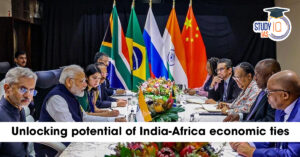Table of Contents
Context: The article is discussing the recent outbreak of ethnic violence in Manipur. The violence has resulted in numerous casualties, displaced people, and deepened the divide between the Meiteis and the Kuki-Chin-Mizo-Zomi-Naga tribes. The author emphasizes that despite developments in the region, there remains a significant ethnic divide, fueled by sub-nationalism and identity politics. The author also expresses uncertainty about the effectiveness of the proposed solutions by Home Minister during his visit to Manipur. He calls for sensitive handling, saner voices, innovative thinking, and dialogue to find a solution and prevent the conflict from spreading to other parts of the region.
Background: The recent ethnic violence in Manipur
- Recently, a violent ethnic clash erupted in Manipur, which has led to widespread violence, death and displacement.
- The clash involved the Meitei people, who are the majority residing in the Imphal Valley, and the tribal community from the surrounding hills, including the Kuki and Zo peoples.
- The conflict stemmed from the Meitei people’s demand for Scheduled Tribe status under the Indian Constitution, which would grant them privileges similar to those of the tribal communities.
- The situation escalated after a Manipur High Court verdict directed the state government to decide on the issue.
- The Indian Army deployed troops and imposed curfews to restore order, while investigations and peace committees were established to address the root causes of the violence.
Ethnicity of Manipur
- The Meiteis are the largest community in Manipur.
- There are 34 recognized tribes, which are broadly classified as ‘Any Kuki Tribes’ and ‘Any Naga Tribes’.
- The central valley in the state accounts for about 10% of the landmass of Manipur, and is home primarily to the Meitei and Meitei Pangals who constitute roughly 64.6% of the state’s population.
- The remaining 90% of the state’s geographical area comprises hills surrounding the valley, which are home to the recognized tribes, making up about 35.4% of the state’s population.

Decoding the Editorial
Against the backdrop of ongoing violence, the author highlights that despite the various developments in the northeast, little has changed regarding the deep-rooted divisions in the region. And he expresses a critical perspective on analyzing outbreaks of violence in the northeast region.
Fraying of our composite culture
- The author expresses that despite the prevailing belief that the northeast region had achieved significant development and integration over time, the recent ethnic violence in Manipur has served as a stark reminder that such integration is not as complete as believed.
- He argues that it is easy to make superficial judgments and attribute causes such as regional biases, lack of unity, and ethnic/caste conflicts to internal tensions and violence.
- However, the author notes that these factors have reduced in recent times. He suggests that the weakening of composite culture, which has affected other parts of India as well, might be influencing the situation in the northeast.
Ethnic sub-nationalism and identity politics
- The author argues that ethnic allegiance and identity have historically been in conflict with mainstream nationalism, and it was hoped that these tensions had subsided.
- However, in many parts of the northeast, ethnic identities still overshadow and overwhelm other considerations.
- He highlights the developments in Manipur as an example of how ethnic identities are playing a significant role in the region.
- He mentions that consolidation efforts by different tribal entities are creating subterranean pressures, reopening previously settled issues.
- In Manipur specifically, there are signs of a resurgence of ultra-nationalistic tendencies.
- He says that what we witness in Manipur today is a conflict between charged up Meitei chauvinism seeking to consolidate their position within Manipur and across the region, in opposition to the Kukis, Mizos and other tribes.
Weighing in on the solutions
- The author expresses uncertainty about the effectiveness of the proposed solutions by Home Minister Amit Shah during his visit to Manipur.
- While the announcement of a judicial probe and a three-member committee is seen as positive, the proposal for a unified command to oversee security is viewed as excessive and draconian.
- The decision to change the Director General of Police, who belongs to the Kuki tribe, may worsen the tensions between the Meitei and Kuki communities. The author suggests that these measures could potentially exacerbate the existing conflict.
Way Forward
- The author suggests that saner voices should play a leading role in addressing the situation in Manipur.
- He emphasizes the need for the central government to achieve an “optimal positioning” by demonstrating sensitivity, innovative thinking, and willingness to make concessions.
- He also emphasizes the importance of understanding cultural factors and sociological dynamics in finding a solution.
- The author also stresses the significance of dialogue, avoiding an adversarial approach, and communicating the neutrality of Delhi in conflicts.
- The key solutions proposed include finding a mutually agreeable agreement, acknowledging the magnitude of the problem, ensuring security for all communities, and acting based on overreaching moral principles while maintaining a weak democratic resolve and shared national interest.


 Micrometeoroids: Tiny Space Particles, M...
Micrometeoroids: Tiny Space Particles, M...
 India Needs a National Insolvency Tribun...
India Needs a National Insolvency Tribun...
 Unlocking the Potential of India–Afric...
Unlocking the Potential of India–Afric...

























